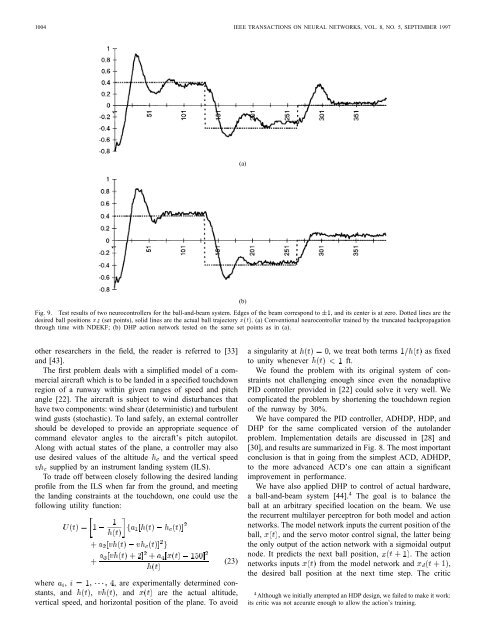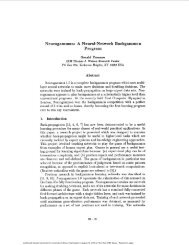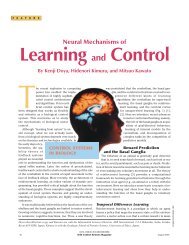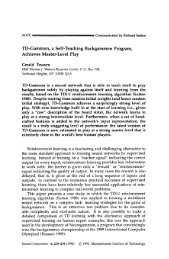Adaptive Critic Designs - Neural Networks, IEEE ... - IEEE Xplore
Adaptive Critic Designs - Neural Networks, IEEE ... - IEEE Xplore
Adaptive Critic Designs - Neural Networks, IEEE ... - IEEE Xplore
- No tags were found...
Create successful ePaper yourself
Turn your PDF publications into a flip-book with our unique Google optimized e-Paper software.
1004 <strong>IEEE</strong> TRANSACTIONS ON NEURAL NETWORKS, VOL. 8, NO. 5, SEPTEMBER 1997(a)(b)Fig. 9. Test results of two neurocontrollers for the ball-and-beam system. Edges of the beam correspond to 61, and its center is at zero. Dotted lines are thedesired ball positions x d (set points), solid lines are the actual ball trajectory x(t). (a) Conventional neurocontroller trained by the truncated backpropagationthrough time with NDEKF; (b) DHP action network tested on the same set points as in (a).other researchers in the field, the reader is referred to [33]and [43].The first problem deals with a simplified model of a commercialaircraft which is to be landed in a specified touchdownregion of a runway within given ranges of speed and pitchangle [22]. The aircraft is subject to wind disturbances thathave two components: wind shear (deterministic) and turbulentwind gusts (stochastic). To land safely, an external controllershould be developed to provide an appropriate sequence ofcommand elevator angles to the aircraft’s pitch autopilot.Along with actual states of the plane, a controller may alsouse desired values of the altitude and the vertical speedsupplied by an instrument landing system (ILS).To trade off between closely following the desired landingprofile from the ILS when far from the ground, and meetingthe landing constraints at the touchdown, one could use thefollowing utility function:(23)where , , are experimentally determined constants,and , , and are the actual altitude,vertical speed, and horizontal position of the plane. To avoida singularity at , we treat both terms as fixedto unity whenever ft.We found the problem with its original system of constraintsnot challenging enough since even the nonadaptivePID controller provided in [22] could solve it very well. Wecomplicated the problem by shortening the touchdown regionof the runway by 30%.We have compared the PID controller, ADHDP, HDP, andDHP for the same complicated version of the autolanderproblem. Implementation details are discussed in [28] and[30], and results are summarized in Fig. 8. The most importantconclusion is that in going from the simplest ACD, ADHDP,to the more advanced ACD’s one can attain a significantimprovement in performance.We have also applied DHP to control of actual hardware,a ball-and-beam system [44]. 4 The goal is to balance theball at an arbitrary specified location on the beam. We usethe recurrent multilayer perceptron for both model and actionnetworks. The model network inputs the current position of theball, , and the servo motor control signal, the latter beingthe only output of the action network with a sigmoidal outputnode. It predicts the next ball position, . The actionnetworks inputs from the model network and ,the desired ball position at the next time step. The critic4 Although we initially attempted an HDP design, we failed to make it work:its critic was not accurate enough to allow the action’s training.









